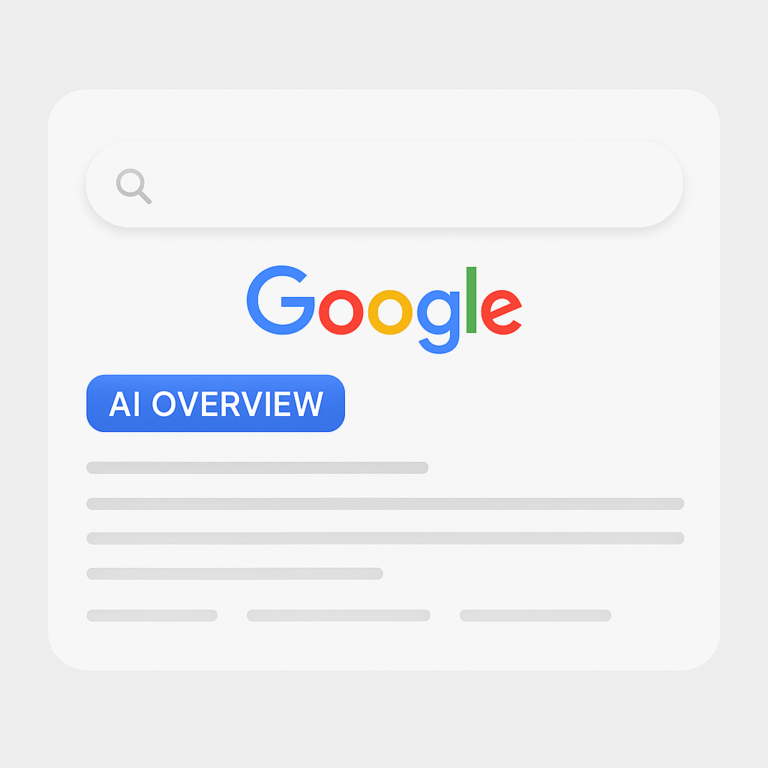In May 2024, Google quietly rolled out one of the biggest shifts to search behavior in over a decade: AI-generated summaries, also known as AI Overviews. These summaries now appear at the top of many search results, offering users quick, AI-generated responses pulled from various websites. At first glance, this looks like progress—faster answers, and a sleeker experience. But for marketers, it introduces a complex challenge: your content might be used to answer a query, without ever earning a click.
For brands investing in SEO and paid search, this creates an overlap we can’t ignore. When AI Overviews show up above both ads and organic listings, it impacts visibility, click-through rates, and user behavior. At Ai Media Group, we believe this is a turning point, not just for strategy, but for structure. It’s time for SEO and paid search to stop competing and start working together to drive the bottom line.
What Are Google’s AI Overviews, Really?
Google has provided limited transparency around how AI Overviews select and display content. Their official guidance on AI Overviews simply reiterates longstanding SEO best practices: build authoritative content, use structured data, and create a strong user experience. While that advice remains valid, it doesn’t paint the full picture of how AI-generated answers are actually constructed, or how to influence them.
We do know that AI Overviews don’t always favor top-ranked pages. Instead, they prioritize content that clearly and directly answers the user’s question, even if that content comes from a lower-ranked or lesser-known site. Google’s AI leans on natural language processing to understand intent, semantics, and entities, not just keywords, meaning it can surface results based on conceptual relevance rather than page authority. AI Overviews regularly pull from sources outside of the top organic results, including content from Reddit, forums, and newer websites.
The AI also draws from multiple sources at once, blending them into a single cohesive answer. That’s why you may see citations from niche blogs, Reddit threads, or Quora responses, even when those pages don’t appear on the first page of traditional results. This is a signal that freshness and clarity matter just as much as rank. Structured content, such as bullet points, FAQ formats, and schema markup, also seems to perform better, likely because it’s easier for the AI to parse and present.
In short: this isn’t a tweak to the algorithm. It’s a rethinking of how search answers are sourced, assembled, and delivered. And it changes how we show up: whether we’re trying to rank organically, or drive performance through paid.
The Impact on Paid Ads
Google’s AI Overviews aren’t just changing organic search, they’re reshaping how paid ads perform, too. When these summaries appear above the ad section, they reduce visibility for top- and mid-funnel campaigns. Users often find what they need without scrolling, leading to fewer impressions and lower CTR.
We’re also seeing a shift in query behavior. Users refine their searches after reading an AI Overview, making it harder for early-stage ads to capture attention. Meanwhile, CPC is climbing for bottom-funnel keywords, as more competition gets funneled into fewer high-intent moments.
In other words: paid search isn’t disappearing, but the way users interact with it is changing fast. And it’s no longer enough to just bid on keywords. You need to understand where, and when, your ads show up in the user journey, especially in a search environment now partially curated by an AI layer.
How Ai Media Group Is Adapting
We see it as a strategic reset.
We’re treating Google’s AI Overviews as a signal to integrate paid search and SEO more tightly than ever. These two functions, often siloed, now need to work hand-in-hand to support full-funnel performance.
We’re guiding our clients to:
- Shift budget toward high-intent queries, where AI Overviews are less dominant and users are closer to making decisions.
- Strengthen their on-site content, especially FAQ sections, structured pages, and product/service landing pages that can contribute to both rankings and AI citations.
- Rethink ad creative and extensions to stand out visually and contextually—especially when competing with a polished AI summary above the fold.
- Use Performance Max, Discovery, and Demand Gen campaigns to reach users outside traditional search, where the AI layer doesn’t control visibility.
- Take advantage of refined audience targeting, as we’re seeing ads increasingly surface for users further along in their research journey. That means more qualified traffic, even if it’s slightly lower in volume.
- Lean into high-impact formats like Ad Extensions and Shopping Ads, which still stand out on the SERP, even when traditional text ads are pushed lower by AI Overviews.
- Closely monitor impression share and CTR trends, to understand whether drops in performance are coming from competitor activity or a changing SERP layout.
Bottom line: this is where SEO and paid search come together. AI Overviews are raising the bar on relevance, quality, and timing, and we’re helping brands meet that challenge by making sure every piece of their search strategy is working toward the same goal: driving measurable results.
Seems like a lot? Make sure you have an agency that can handle it.



